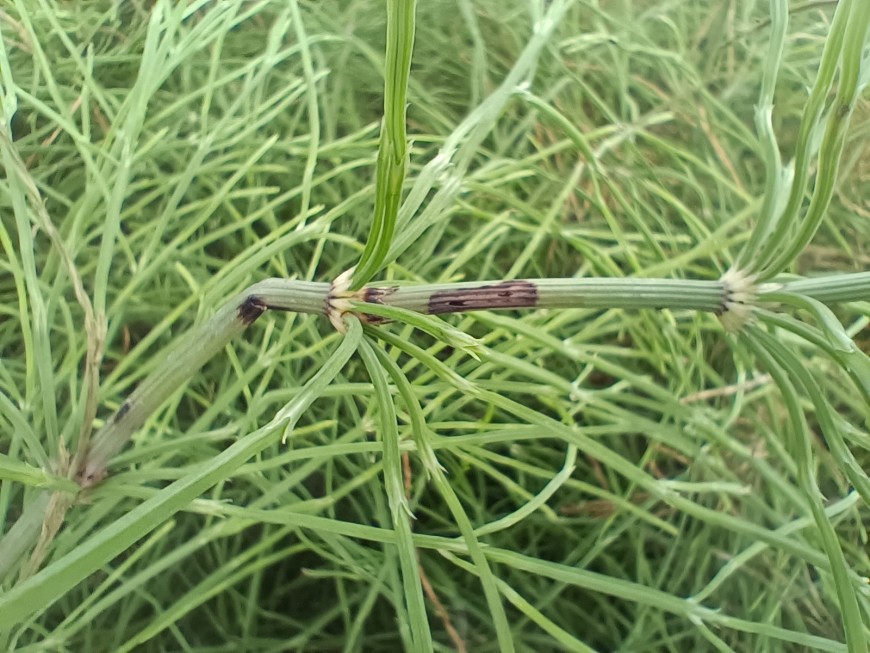Field horsetail weevil
History in New Zealand
The field horsetail weevil is native to Eurasia and North America. It was first imported into containment in New Zealand for study in 2013 by Manaaki Whenua - Landcare Research on behalf of the Lower Rangitikei Horsetail Control Group. Permission to release the weevils was granted by the EPA in mid-2016, and the first field release was made in 2017. The weevil has not been used as a biocontrol agent anywhere in the world before. It is likely to be the only agent needed to provide adequate control for field horsetail; but, if not, there are other agents that can be considered.
How would I find/recognise them and what is their lifecycle?
The adults are 6-8mm long with mostly black wing cases, but creamy at the tips, and black and brown speckled undersides. Females are generally a bit larger than males. They readily drop from the plant when disturbed which will make them difficult to see in the field. The adults are likely to be relatively long-lived as they have been observed to live for at least several months in the lab.

Image: field horsetail weevil (Grypus equiseti).
You are also unlikely to see the eggs despite them being orange and relatively large (0.5mm), as the female deposits 1-6 of them into a feeding cavity within the horsetail stem and then often seals the opening.

Image: field horsetail weevil eggs.
The larvae are grub-like and creamy-yellow in colour with tan head capsules. They hatch within the horsetail stems in late summer and then burrow or mine down into the below ground rhizomes. The larvae overwinter in the rhizomes and then pupate, emerging as new adults the following summer. Only one generation is completed each year.
Image: field horsetail weevil larva.
Since all stages of the insect will be difficult to see in the field, the best thing to look for will be their damage in spring and summer. There is no other insect on field horsetail that you are likely to confuse with this weevil. However, natural dieback that occurs in autumn/winter could be confused with weevil damage so look instead in spring/summer.
How do they damage field horsetail?
Both the adults and the larvae feed on horsetail. The adults eat their way into horsetail stems, hollowing out large cavities, and effectively killing the stem above the feeding area. Larvae may kill the entire stem as they burrow down into the roots, where they continue to feed and damage the rhizomes.

Image: field horsetail weevil adult feeding hole.

Image: stem damage from the adult field horsetail weevil.
Will they attack other plants?
In its native range, the horsetail weevil attacks a range of horsetail species and host-range testing has indicated that the other horsetail species also present in New Zealand, Equisetum hymale, is a potential host. However, no other plants are expected to be at risk.
How effective are they?
It is too soon to know what impact the horsetail weevil will have in New Zealand. However, in the lab, potted field horsetail plants are severely damaged by the weevil and it is expected to be capable of having a substantial impact.
How can I get the most out of this agent?
If the horsetail weevil establishes at initial release sites, it would be worth helping to establish them in all areas where they are needed. The weevil is likely to disperse fairly slowly, possibly only a few kilometres per year.
How do I select a release site?
Read Guidelines for selecting release sites for biocontrol agents.
How do I collect them for release at other sites?
When adults are present in good numbers, either collect them by sweeping infested horsetail with a butterfly net or by sucking them up with a garden leaf vacuum machine. Modify the tube of the garden-leaf vacuum so that the weevils are collected and not sucked through. Take a sleeve of coarsely-woven material, with one end sewn or tied shut and the other end open (old socks or pantyhose could also be used), and fit it securely around the end so that it forms a bag in the mouth of the tube. Use a pooter to separate the weevils from other material collected during the vacuuming process, which many include pasture pests.
Place collected adults into a chillybin to transport to a new site. Shift at least 100 individuals to each new site at any time during mid to late summer. This will allow time for development of new larvae before horsetail dies back for winter. Sheltered release sites are recommended.
Image: field horsetail weevil first New Zealand release, November 9th 2017.
How do I manage the release sites?
Avoid any activities that will interfere with the weevils, such as herbicide application. If you need to undertake control measures, then avoid the release site.
Key contact



